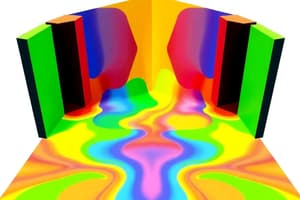Podcast
Questions and Answers
What is the primary characteristic of orthographic projection?
What is the primary characteristic of orthographic projection?
- It combines multiple views into a single image.
- It only represents objects in one viewpoint.
- It maintains true dimensions without distortion. (correct)
- It distorts dimensions to enhance perspective.
In first-angle projection, how are views represented in relation to the object?
In first-angle projection, how are views represented in relation to the object?
- Object is placed in the second quadrant for representation.
- Views appear to come from below the object.
- Views are projected onto the planes behind the object. (correct)
- Views are placed in front of the object.
Which of the following shapes is NOT a common component of a net used for a pyramid?
Which of the following shapes is NOT a common component of a net used for a pyramid?
- Square faces
- Hexagonal faces (correct)
- Triangular faces
- Rectangular faces
Which net can be used to create a cylinder?
Which net can be used to create a cylinder?
What is a primary use of nets in geometry?
What is a primary use of nets in geometry?
Flashcards are hidden until you start studying
Study Notes
2D and 3D and Projection View
Orthographic Projection
- Definition: A method of representing three-dimensional objects in two dimensions.
- Characteristics:
- Maintains true dimensions without distortion.
- Multiple views are typically used (frontal, top, and side).
- Types:
- First-angle Projection: The object is placed in the first quadrant; the view is projected onto the planes behind the object.
- Third-angle Projection: The object is placed in the third quadrant; views are projected onto the planes in front of the object.
- Applications: Widely used in engineering drawings, architectural designs, and technical illustrations.
Nets
- Definition: A two-dimensional representation of a three-dimensional object that can be folded to form the object.
- Components:
- Composed of faces that represent the sides of the 3D object.
- Each face is connected in a way that allows for assembly into the 3D shape.
- Common Shapes:
- Cube: Composed of 6 square faces arranged in a cross shape.
- Pyramid: Composed of triangular and square faces, arranged to show how they fold together.
- Cylinder: Includes rectangles for the curved surface and circles for the top and bottom faces.
- Uses: Helpful for visualizing and constructing 3D shapes, teaching geometry, and in crafts and design projects.
Orthographic Projection
- Represents three-dimensional objects in two dimensions, allowing for accurate visual representation.
- True dimensions are preserved, avoiding any distortion in the views.
- Typically involves multiple views, including frontal, top, and side perspectives for comprehensive understanding.
- First-angle Projection: The object is located in the first quadrant, with views projected onto the planes behind it.
- Third-angle Projection: The object sits in the third quadrant, and views are projected onto the planes in front.
- Commonly utilized in engineering drawings, architectural designs, and technical illustrations for clarity and precision.
Nets
- A two-dimensional representation that can be folded into a three-dimensional object, making it a useful geometric tool.
- Composed of flat faces that correspond to the sides of the 3D object, allowing for clear visual understanding of its structure.
- Common Shapes:
- Cube: Features 6 square faces arranged in a cross shape that can be constructed into a 3D cube.
- Pyramid: Includes triangular and square faces, arranged to illustrate how the pieces fold to form a pyramidal shape.
- Cylinder: Consists of rectangular sections representing the curved surface, with circular faces for the top and bottom.
- Utilized in various applications such as visualizing and constructing three-dimensional shapes, teaching geometric concepts, and in design and craft projects.
Studying That Suits You
Use AI to generate personalized quizzes and flashcards to suit your learning preferences.




